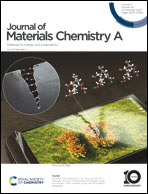Li–Mn–O Li-rich cation disordered rock-salt cathode materials do not undergo reversible oxygen redox during cycling†
Abstract
An in-depth study of “Li4Mn2O5”, a nanocomposite of Li2O and Li4−xMn2O5 with a disordered rock salt structure (LMO), was conducted to determine the origins of the observed anomalously high charge and discharge capacity in lithium cells, which can exceed 350 mA h g−1. Using soft and hard X-ray absorption spectroscopy (XAS), mapping of resonant inelastic X-ray scattering (mRIXS), and X-ray Raman spectroscopy (XRS), it was determined that electrochemical decomposition of Li2O upon charge and reduction of Mn to below 3+ during discharge is responsible for the capacities that are observed, with no evidence of contributions from reversible oxygen redox. The over-reduction is exacerbated when charging limits of 4.5–4.8 V are used due to side reactions between electrolytic solution and the highly oxidized active material. These side reactions result in dissolution of Mn at room temperature and release of oxygen and other gases during initial cycles, which, in turn, cause rapid capacity fading. This is accompanied by evolution of the voltage profile upon cycling towards one that resembles that of manganese oxide spinels. The cycling behavior can be improved somewhat by reducing the upper voltage limit, although this results in a diminishment of the discharge capacities below 200 mA h g−1. By adding various amounts of spinel LiMn2O4 during synthesis, it was possible to produce LMOs with rock salt structures having significantly improved cycling behavior but still having capacities in excess of 250 mA h g−1. An optimized modified material also exhibits better rate capability and much less gas evolution during initial cycles than the unmodified LMO. Interestingly, as-made modified materials generally exhibited lower than expected average Mn oxidation states attributable to oxygen loss during the synthesis process, as well as higher capacities than expected based on their manganese contents. The oxygen loss during processing may reduce the activity of the remaining oxygen and account for the lower reactivity of the spinel-modified material.



 Please wait while we load your content...
Please wait while we load your content...